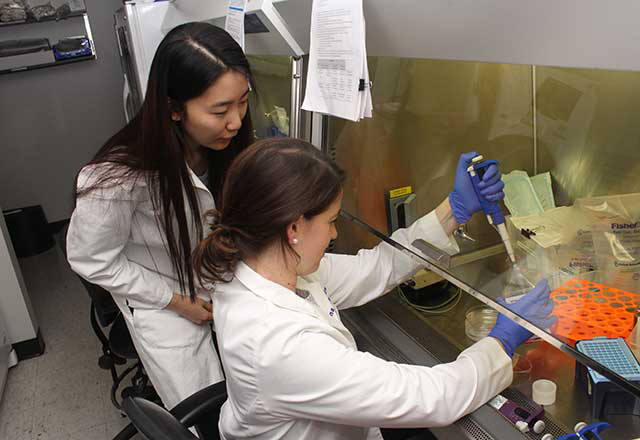Types of Cores
Which type of core facility are you operating or would you like to set up? See which operational, administrative and financial model is best for you.
On This Page
-
*Institutional Service Center Core Facilities
Offer services to internal and external customers, have annual revenue over $100K, adhere to Uniform Guidance 2 CFR 200 guidelines for service centers.

-
Departmental Core Facilities
May offer services outside of department, have annual revenue less than $100K, adhere to Departmental guidelines for operation.

-
Collaborative / Shared Core Facilities
Collaborations among members, not open access or fee for service, develop new techniques supported by grant or departmental funds.

-
Limited Access Core Facilities
Cores restricted to a group of investigators associated with a specific grant (ie – NIH P30).

*There are some service centers that are reserved for "the use of highly complex or specialized facilities" (SSF). They have annual operating budgets exceeding $1 million in estimated annual direct costs or revenues. Facility and administrative costs should be allocated to the center based on identifiable square feet.
These guidelines provide investigators, core personnel and administrative staff a framework for the administrative operations of shared research resources — referred to as “cores,” “core facilities” or “service centers” — at The Johns Hopkins University.
Our Johns Hopkins Medicine research core facilities exist to provide access to instrumentation, equipment, facilities and professional expertise to support basic, translational and clinical research. These services must be unique and/or not widely available commercially from outside sources. Our core facilities are organized using a variety of operational, administrative and financial models that are further defined below. Collectively, these units are referred to as research core facilities, but they can be classified into four main types. Each type offers unique contributions to our mission and research ecosystem that accelerates collaboration, innovation, quality and impact of all research from curiosity-driven basic discovery to implementation sciences.
A. Institutional Service Center Core Facilities (More Than $100,000 Revenue per Year)
Service center cores are created upon the approval of Business Offices and the Office of Cost Analysis to provide equipment or services on a fee-for-service basis to the Johns Hopkins Medicine research community. They have the following characteristics:
- Provide services and equipment that fall beyond the financial reach or regular use of an individual investigator.
- Generate services with annual revenue greater than $100,000.
- Demonstrate demand beyond their home department, center or institute, with Johns Hopkins Medicine investigators comprising a majority of users.
- Adhere to federal cost accounting guidelines in OMB Circular A-21.
- Calculate and document cost-based rate(s) and publish fee schedule.
- Establish and monitor a separate cost object (internal order or cost center) to capture revenue and expenses for the service center.
- Develop a method or system to track actual usage of equipment or service provided.
- Bill internal and external users on a routine, timely basis.
- Submit an annual rate schedule and budget to the Office of Cost Analysis and the Divisional Business Office to review operating surpluses or deficits.
- User fees must be based on the core’s actual expenses and be reasonable and competitive when compared with other institutions or commercial companies offering similar services.
- Provide training and education as part of their services.
B. Departmental Core Facilities (Less Than $100,000 Revenue per Year)
Core facilities are created by departments or institutes to provide equipment or services to the Johns Hopkins Medicine research community. They have the following characteristics:
- Provide services and equipment that fall beyond the financial reach or regular use of an individual investigator.
- Generate services with annual revenue less than $100,000.
- Demonstrate demand beyond their home department, center or institute, with Johns Hopkins Medicine investigators comprising a majority of users.
- Calculate and document cost-based rate(s) and may or may not publish fee schedule.
- Establish and monitor a separate cost object (internal order or cost center) to capture revenue and expenses for the service center.
- Develop a method or system to track actual usage of equipment or service provided.
- Bill internal and external users on a routine, timely basis.
- Receive oversight from their home department, center or institute to review operating surpluses or deficits.
C. Collaborative/Shared Core Facilities
Collaborative core facilities are research-oriented cores that have special expertise and equipment that do not fit unit pricing. In many cases, investigators accomplish their work by collaborating with members of the core. They are not open access or fee for service. Often times they exist to develop new techniques and methods for research. An example of this type of core facility is the Johns Hopkins Kimmel Cancer Center’s Bioinformatics Shared Resource. These cores are supported by departmental funds, grants, collaborations established with users of the core and support negotiated directly from the vice dean for research.
D. Limited Access Core Facilities
Some core facilities exist to serve a restricted group of investigators who are associated with a specific grant (e.g., National Institutes of Health P class grants) or support investigators within a specific department or institute. Typically these cores do not operate as fee for service. Some National Institutes of Health P grant cores evolve into service center core facilities or core facilities after the termination of a grant and continue to provide services or equipment on a fee-for-service basis.
